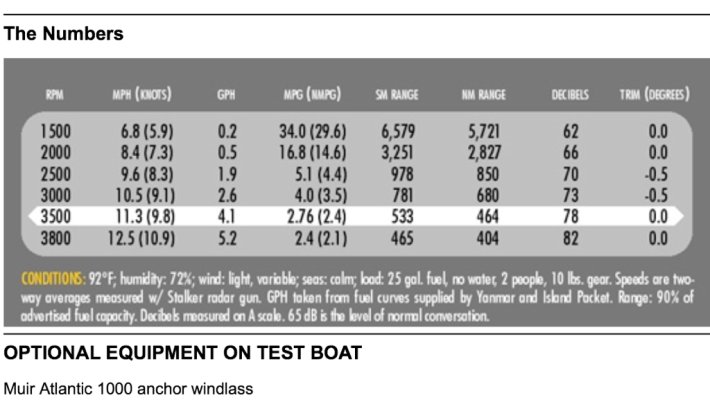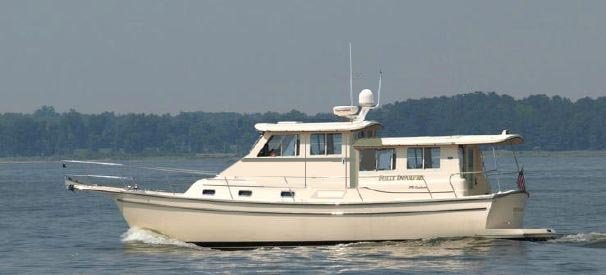cardude01
Guru
- Joined
- Nov 26, 2012
- Messages
- 5,290
- Location
- USA
- Vessel Name
- Bijou
- Vessel Make
- 2008 Island Packet PY/SP
I recently had a PY Cruiser surveyed, and on the sea trial the speeds at different RPMs were quite a bit slower than what I expected after reading this data from a test done back in 2008:

The full article is here.
Island Packet PY 41
We were only able to get 7.8 knots at WOT of 3200, and about 6 knots at 2600 rpm. When I plug the boat's data into the boatdiesel calculator it shows a theoretical hull speed of 7.8 knots using the following inputs:
displacement hull, 23000 lbs displacement, 35' LWL, 4JH4-HTE Yanmar 109hp (500 hours) at 3200 rpm , 2.63-1 trans ratio. 21X16 three blade prop.
The calculator figures 46 hp at 2400 rpm needed to get to the 7.8 knots, but like I said we needed 3200 to get there. This Yanmar supposedly makes about 46 hp at 2400 rpm.
Is there a logical explanation for needing full power to reach hull speed?
The bottom had a little growth but not much. We were in calm water. Not much wind.
We were more heavily loaded than the boat in the test article by about 2000 lbs.
Could our hand held GPS have been that far off? The GPS on the boat was inop at the time.

The full article is here.
Island Packet PY 41
We were only able to get 7.8 knots at WOT of 3200, and about 6 knots at 2600 rpm. When I plug the boat's data into the boatdiesel calculator it shows a theoretical hull speed of 7.8 knots using the following inputs:
displacement hull, 23000 lbs displacement, 35' LWL, 4JH4-HTE Yanmar 109hp (500 hours) at 3200 rpm , 2.63-1 trans ratio. 21X16 three blade prop.
The calculator figures 46 hp at 2400 rpm needed to get to the 7.8 knots, but like I said we needed 3200 to get there. This Yanmar supposedly makes about 46 hp at 2400 rpm.
Is there a logical explanation for needing full power to reach hull speed?
The bottom had a little growth but not much. We were in calm water. Not much wind.
We were more heavily loaded than the boat in the test article by about 2000 lbs.
Could our hand held GPS have been that far off? The GPS on the boat was inop at the time.
Last edited:






